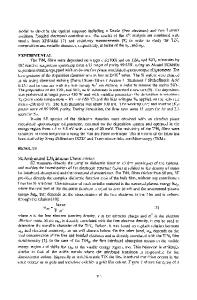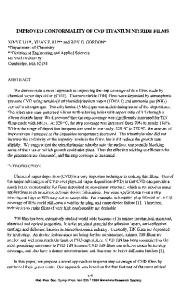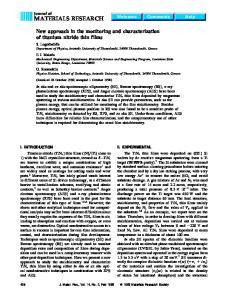In situ characterization of fracture toughness and dynamics of nanocrystalline titanium nitride films
- PDF / 510,154 Bytes
- 10 Pages / 584.957 x 782.986 pts Page_size
- 66 Downloads / 274 Views
Jia-Hong Huang Department of Engineering and System Science, National Tsing Hua University, Hsinchu 30013, Taiwan
Jian-Min Zuoa) Department of Materials Science and Engineering, University of Illinois at Urbana-Champaign, Urbana, IL 61801, USA (Received 21 May 2015; accepted 15 December 2015)
We designed a clamped beam bending test using a nanoindentation holder with help of transmission electron microscopy (TEM) and focused ion beam specimen fabrication. The microstructure evolution and crack propagation in nanocrystalline TiN were studied by electron imaging and load–displacement measurements during mechanical loading. By measuring the loads under which the crack starts and stops propagating and the time, we obtained the film’s fracture toughness using the finite element method and crack propagation speed. Among these, we identified three types of crack propagation pathways, namely bridging, intergranular and a mixed mode of transgranular and intergranular fracture, and the associated microstructure changes. The measured fracture toughness is in agreement with the reported values. Thus, our in situ TEM bending test provides the first direct measurement of fracture toughness in a TEM and a correlation of fracture toughness with fracture toughening mechanisms in nanocrystalline TiN. The method is general and can be applied to other nanocrystalline materials.
I. INTRODUCTION
Nanocrystalline metals and ceramics have attracted considerable interests in the past decade due to the observation and expectation of their high strength, high hardness, and good fatigue resistance.1–13 However, nanocrystalline materials show low ductility at room temperature,1,14–16 which limits their applications. Thus, it is very important to understand the fracture mechanisms operating in these systems. In nanocrystalline metals, a fracture surface is characterized with dimpled structures whose sizes are larger than the grain size. Hasnaoui et al.16 used molecular dynamics to simulate the fracture process of nanocrystalline nickel and their results suggested that the formation of local shear planes contributed to the dimpled characteristics on the fracture planes. Shan et al.14 conducted in situ tensile straining on nanocrystalline nickel in a transmission electron microscope (TEM). Grain agglomerates were found to form rapidly and frequently ahead of an advancing crack, which was used to explain the formation of dimpled
Contributing Editor: George M. Pharr a) Address all correspondence to this author. e-mail: [email protected] DOI: 10.1557/jmr.2016.4 370
J. Mater. Res., Vol. 31, No. 3, Feb 15, 2016
structure. However, there are few reports on fracture mechanisms of nanocrystalline ceramics. It has been proposed that nanocrystalline ceramics consist of a large portion of grain boundary (GB) atoms compared with nanocrystalline metals17 and the mechanical properties and fracture mechanisms of nanocrystalline ceramics are mainly determined by the amorphous and soft GB phases. GBs act as preferable places for crack nucleation and propagatio
Data Loading...











